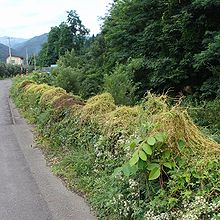| Cuscuta japonica | |
|---|---|

| |
| Scientific classification | |
| Kingdom: | Plantae |
| Clade: | Tracheophytes |
| Clade: | Angiosperms |
| Clade: | Eudicots |
| Clade: | Asterids |
| Order: | Solanales |
| Family: | Convolvulaceae |
| Genus: | Cuscuta |
| Species: | C. japonica |
| Binomial name | |
| Cuscuta japonica Choisy | |
| Synonyms | |
|
Monogynella japonica (Choisy) Hadac & Chrtek | |
Cuscuta japonica, commonly known as Japanese dodder, is a parasitic vine. It has been listed by the State of California as a noxious weed. It has a range of effects on its host and has repeatedly been introduced to the United States of America. C. japonica looks very similar to other vines, making it difficult to distinguish.
Effects on host
The Japanese dodder is a plant that parasitizes other plants. From mild development issues to serious complications sometimes resulting in death, the Japanese dodder can cause a wide spectrum of effects on its plant host. Farmers in particular can be affected by this plant, as infection leads to less crops they are able to harvest.
Morphology
Cuscuta japonica shares a similar morphology to vines, displaying stems that are mostly yellow with bits of red along it. The Japanese dodder also exhibits small flowers that are "pale-yellow to cream" in color and contain one circular stigma. Any leaves it has are very small and "scale-like" in shape and texture. Fruit produced are small and capsule-like, only carrying a couple of seeds.
History
Cuscuta japonica can be found non-invasively in a variety of places on the continent of Asia. The plant was introduced and reintroduced to the United States of America multiple times starting from the 1940s under the guise of a medicinal plant, and was thought to have been eradicated a couple of times.
References
- "Cuscuta japonica Choisy". Plants of the World Online. The Trustees of the Royal Botanic Gardens, Kew. n.d. Retrieved December 18, 2022.
- "Cuscuta japonica Choisy". Catalogue of Life. Species 2000. n.d. Retrieved December 18, 2022.
- "Noxious Weed Information Project: Japanese Dodder". California Department of Food and Agriculture. Archived from the original on 2010-11-22. Retrieved 2021-05-18.
- ^ Dara, Surendra (2011-09-01). "Japanese dodder, an exotic and noxious weed found in Santa Barbara County". University of California Agriculture and Natural Resources. Retrieved 2020-03-01.
- ^ "Cuscuta japonica (Japanese dodder)". www.cabi.org. Retrieved 2020-03-02.
- Kaiser, Bettina; Vogg, Gerd; Fürst, Ursula B.; Albert, Markus (2015-02-04). "Parasitic plants of the genus Cuscuta and their interaction with susceptible and resistant host plants". Frontiers in Plant Science. 6: 45. doi:10.3389/fpls.2015.00045. ISSN 1664-462X. PMC 4316696. PMID 25699071.
- "Dodder". University of California Agriculture and Natural Resources. March 2010. Archived from the original on 2016-07-08. Retrieved 2020-03-01.
- Park, Inkyu; Song, Jun-Ho; Yang, Sungyu; Kim, Wook Jin; Choi, Goya; Moon, Byeong Cheol (2019-06-03). "Cuscuta Species Identification Based on the Morphology of Reproductive Organs and Complete Chloroplast Genome Sequences". International Journal of Molecular Sciences. 20 (11): 2726. doi:10.3390/ijms20112726. ISSN 1422-0067. PMC 6600609. PMID 31163646.
- ^ "Japanese dodder, Cuscuta japonica Solanales: Cuscutaceae". www.invasive.org. Retrieved 2020-03-02.
| Taxon identifiers | |
|---|---|
| Cuscuta japonica |
|